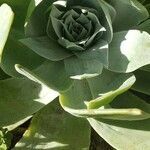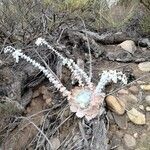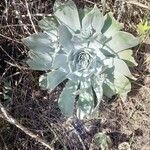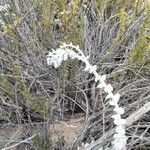Caudices (becoming decumbent), simple, to 50 × 4-10 cm, (densely covered proximally with old leaves), axillary branches absent. Leaves: rosettes solitary, not in clumps, 30-80-leaved, 25-60 cm diam.; blade chalky white, oblong to oblong-oblanceolate, widest at base or in distal 1/3, 8-25(-30) × 3-10[-13] cm, 3-10 mm thick, base 3-8 cm wide, apex acuminate to cuspidate, surfaces puberulent, chalky. Inflorescences: cyme mostly densely 2-5-branched, obpyramidal to cylindric; branches twisted at base (flowers on underside), simple or 1 times bifurcate; cincinni 2-5, (in age straight and spreading to erect), 10-30-flowered, circinate, 10-50 cm; floral shoots 30-100 [-150] × 0.5-2 cm; leaves 20-70, spreading to deflexed, (becoming red), cordate-ovate to suborbiculate, 20-50 × 15-30 mm, apex acuminate. Pedicels pendent or declined, in age sharply bending near middle to bring fruits ± erect, 10-35 mm. Flowers: calyx 5-9 × 5-8 mm; petals connate 6-10 mm, red, 11-19 × 2-4.5 mm, apex acute to obtuse, tips erect; pistils connivent, erect. Unripe follicles erect. 2n = 34.
More
A succulent plant. It grows a rind of wide, flat, fleshy leaves. They are pale green. These spread 45 cm across. It produces a tall erect stem 60 cm long. The plant has a coating of powdery wax. There are many flowers on a flower stalk. They are reddish.




